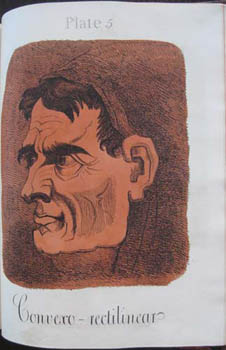
Author: SCHIMMELPENNINCK, Mary Anne.
Title: Theory on the Classification of Beauty and Deformity, and their correspondence with physiognomic expression, exemplified in various works of art, and natural objects ...
Description: London, for J. & A. Arch 1815. Quarto contemporary half calf (a bit rubbed); xviii,441pp, two folding tables (the title calls for four and two of these are in the text) and 38 plates with hand colouring. Corner clipped from the half title; a pleasing, fresh copy. ¶ First edition; a re-written, pedestrian and more pious version was published after her death, in 1859. Mrs Schimmelpenninck offers a complete theory of taste rather than a work on physiognomy. Indeed much of the planned physiognomic section has been deferred. The theory here will "furnish a systematically arranged classification [and] fixed and definite rules .. of useful application not only in painting, sculpture, architecture, landscape gardening, poetry, .. but likewise .. in all those minor departments of good taste which constitute the agreeable everyday scenery of life". This theory seems to have been evolving since her childhood and is supported by copious notes and quotations on Chinese gardens, Peruvians, catacombs, sweating sickness, and much more. She investigates the association of ideas, vision, form and motion, colour, hearing, touch, taste and smell, and the two large charts epitomise the whole theory. The plates are mostly soft ground etchings against strong wash backgrounds within a variety of borders. Mrs Schimmelpenninck was too young to be one of the original bluestockings but she was very much their daughter; no social revolutionary but a pamphleteer for abolition and an historian of the Jansenists despite her quaker upbringing. This is her most ambitious and most singular work - it is singular enough in any context - but was no great success: "It was the opinion of some competent judges that this work showed more of her original talent and genius than any other of her published writings but it did not prove popular. It was encumbered by most voluminous notes containing a mass of information not likely perhaps to be generally interesting though testifying abundantly to the author's rare and extensive literary research." (Life of Mary Anne Schimmelpenninck; Christiana C. Hankin, 1858).
Keywords: art aesthetics theory philosophy c19th England
Title: Theory on the Classification of Beauty and Deformity, and their correspondence with physiognomic expression, exemplified in various works of art, and natural objects ...
Description: London, for J. & A. Arch 1815. Quarto contemporary half calf (a bit rubbed); xviii,441pp, two folding tables (the title calls for four and two of these are in the text) and 38 plates with hand colouring. Corner clipped from the half title; a pleasing, fresh copy. ¶ First edition; a re-written, pedestrian and more pious version was published after her death, in 1859. Mrs Schimmelpenninck offers a complete theory of taste rather than a work on physiognomy. Indeed much of the planned physiognomic section has been deferred. The theory here will "furnish a systematically arranged classification [and] fixed and definite rules .. of useful application not only in painting, sculpture, architecture, landscape gardening, poetry, .. but likewise .. in all those minor departments of good taste which constitute the agreeable everyday scenery of life". This theory seems to have been evolving since her childhood and is supported by copious notes and quotations on Chinese gardens, Peruvians, catacombs, sweating sickness, and much more. She investigates the association of ideas, vision, form and motion, colour, hearing, touch, taste and smell, and the two large charts epitomise the whole theory. The plates are mostly soft ground etchings against strong wash backgrounds within a variety of borders. Mrs Schimmelpenninck was too young to be one of the original bluestockings but she was very much their daughter; no social revolutionary but a pamphleteer for abolition and an historian of the Jansenists despite her quaker upbringing. This is her most ambitious and most singular work - it is singular enough in any context - but was no great success: "It was the opinion of some competent judges that this work showed more of her original talent and genius than any other of her published writings but it did not prove popular. It was encumbered by most voluminous notes containing a mass of information not likely perhaps to be generally interesting though testifying abundantly to the author's rare and extensive literary research." (Life of Mary Anne Schimmelpenninck; Christiana C. Hankin, 1858).
Keywords: art aesthetics theory philosophy c19th England
Price: AUD 2750.00 = appr. US$ 1902.65 Seller: Richard Neylon, Bookseller
- Book number: 8203
- Book number: 8203